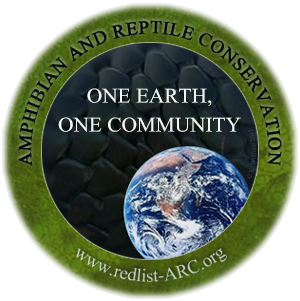|
SOUTH
AMERICA
NOTIFICATION:
This website and its affiliates are the official Internet website portals for the Amphibian
and Reptile Conservation journal and our global conservation network. We own all
copyright, exclusive of authors copyright, produced by any proxy fraudulently presenting as
Amphibian and Reptile Conservation including the fraudulent www.amphibian-reptile-conservation.org as published by the "Amphibian and Reptile Conservation organisation"
as an illicit group led by Craig Hassipakis. Craig Hassipakis has a long and dismal history
of fraudulent activities, including recently committing perjury in an attack on our global
conservation network, as we document see Internet Fraud. Craig Hassipakis publishes as
"Amphibian and Reptile Conservation" under this
logo.
We recognise authors copyright
for the articles presented on this page as open access, but consider the publishing website in
violation of our copyright. In respect to the unusual page numbering and Volume/Issue indexing,
the format used is not that of our official journal, and in fact any journal we know of. We
include these articles on our website as a responsibility to our authors, as the articles have
been fraudulently solicited by Craig Hassipakis as an illicit representative of the Amphibian
and Reptile journal. We are doing our best to prevent further problems.
Please submit any
further articles for publication in Amphibian and Reptile Conservation to publisher@redlist-arc.org
The herpetofuana of South America has suffered a
greater loss of species than perhaps any other region. Consequently, research and conservation
concerning amphibian and reptile conservation in this region makes a major contribution to
global amphibian and reptile conservation. We appreciate authors contributions to this field of
research.
For notification of
the publication of our future articles on South
American herpetofauna please
join our members list at MEMBERSHIP
Rediscovery of Andinophryne
olallai Hoogmoed, 1985
(Anura, Bufonidae), an enigmatic and endangered Andean toad. 2014.
Ryan L. Lynch, Sebastian Kohn, Fernando Ayala-Varela, Paul S. Hamilton, Santiago R.
Special Section: pages 1-7. High
Res PDF
Low Res
PDF
Summary: We report the rediscovery of Andinophryne
olallai, an endangered species only known from a single specimen, collected in 1970. At the
type locality, Tandayapa, Pichincha Province, numerous follow-up surveys after 1970 failed to
record the species suggesting that the population is extinct. The rediscovery of A.
olallai took place in 2012 at RÃo Manduriacu, Imbabura Province, Ecuador. Two surveys
suggest that a healthy population of A. olallai survives at the site, with observations of
froglets, juveniles, and adults across numerous stream systems. However, the extent of known
occupancy of the population is small (<1 km2). Further data are presented to update knowledge
of the distribution, ontogeny, morphology, and conservation status of the species. The
population at RÃo Manduriacu is surrounded by logging, mining, and hydroelectric developments
that could compromise its future survival. There is an urgent need to establish a monitoring
program and to protect its remaining population and habitat in the
region.>
Dactyloa clade (Squamata: Iguanidae) from western Ecuador.
2014. Fernando P. Ayala-Varela, Diana Troya-RodrÃguez, Xiomara Talero-RodrÃguez, Omar
Torres-Carvajal. Special Section: pages 8-24. Download: High
Res PDF
Low Res
PDF
Summary: We describe a new species of Anolis from
the western slopes of the Andes of Ecuador, province of BolÃvar. It is referred to (1) the
aequatorialis series based on its moderate size and narrow toe lamellae, and (2) the eulaemus
sub-group based on having a typical Anolis digit, in which the distal lamellae of phalanx III
distinctly overlap the proximal subdigital scales of phalanx II. The new species is most
similar morphologically to A. otongae and A. gemmosus, both from similar
elevations on the western Andean slopes of Ecuador, but differs from these species in
morphology and color patterns. We present a phylogeny based on DNA sequence data as
additional evidence supporting delimitation of the new species. The new species and A.
gemmosus are sister taxa within the “western Dactyloa
clade.”>
The importance of
enrichment for advancing amphibian welfare and conservation goals::A review of a neglected
topic. 2014. Christopher J. Michaels , J. Roger Downie, Roisin Campbell-Palmer.
High
Res PDF
Low Res
PDF
Summary: Enrichment, broadly the provision
of stimuli to improve the welfare of captive animals, is known to be important in husbandry
practice and in the success of ex situ conservation and reintroduction programs. We review the
existing body of research on enrichment for amphibians, as well as that for fish and reptiles,
which may be regarded as behaviorally and neurologically broadly similar to amphibians. Our
review supports the contention that there may be important consequences of enrichment for both
captive welfare and ex situ conservation success in amphibians and that amphibian enrichment
effects may be highly variable
taxonomically.
Caatinga
Ethnoherpetology: Relationships between herpetofauna and people in a semiarid region of
northeastern Brazil. 2014. LÃvia Emanuelle Tavares Mendonça, 2Washington Luiz Silva Vieira,
Rômulo Romeu Nóbrega Alves. High
Res PDF
Low Res
PDF
Summary: We investigated the
interactions between humans and herpetofauna in the semiarid region of ParaÃba State, Brazil. Data
were obtained by means of interviews with 124 hunters or ex-hunters using semi-structured
questionnaires, complemented by informal conversations. We recorded 18 species (17 reptiles and one
amphibian) that local human populations interact with because they have some utilitarian value or
because of conflicting relations with local inhabitants. Implementation of conservation measures
aimed at the herpetofauna in this region is particularly difficult due to the aversion that local
people hold toward many of these species. Therefore, environmental education strategies should be
adopted. These efforts should not be solely directed at species subject to hunting, but should be
all-inclusive and take into consideration the cultural, social, and utilitarian role that governs
the interactions of human populations and the herpetofauna of the
Caatinga.
Reproduction and
spawning behavior in the frog, Engystomops
pustulatus (Shreve
1941). 2014. Santiago R. Ron, Andrea E. Narváez, Giovanna E. Romero. High
Res PDF
Low Res
PDF
Summary: The study of reproductive
strategies is central to understand the demography of populations and the energetic relationships
of the species with their ecosystem. We describe the reproductive ecology and spawning behavior of
the leptodactylid frog Engystomops pustulatus. In addition, we report observations that
suggest the existence of an alternative mating strategy. Our results show that reproduction in
E. pustulatus is characterized by high maternal investment (15% egg mass relative to body
mass). We found evidence of size-assortative mating with a tendency of larger females to mate with
larger males. Clutch size was correlated with female weight, female condition and male size. Larger
females showed a tendency to lay larger foam nests and larger nests contained more eggs. At
reproductive choruses, there was a male-biased operational sex ratio, indicative of high variance
in male reproductive success. We observed an amplectant couple spawning while an additional male
was embedded in the foam. We hypothesize that this behavior is evidence of an alternative mating
strategy where a small non-amplectant male attempts to fertilize the eggs that are extruded by the
amplectant female.
High
prevalence of Batrachochytrium
dendrobatidis in an
Andean frog community (Reserva Las Gralarias, Ecuador). 2014. Juan M. Guayasamin, Ãngela
MarÃa Mendoza, Ana V. Longo, Kelly R. Zamudio, Elisa Bonaccorso. High
Res PDF
Low Res
PDF
Summary: We
report patterns of infection of Batrachochytrium dendrobatidis (Bd) in a cloud forest
amphibian community in the Andean Western Cordillera of Ecuador (Reserva Las Gralarias). Data
were obtained during the rainy seasons of two consecutive years, using qPCR (year 2012) and
endpoint PCR (year 2013). We show that average Bd prevalence in this amphibian community is high
(2012: 35–49%; 2013: 14–32%), but found no evidence of population declines or that Bd is
negatively affecting host populations. We found a significant correlation between Bd prevalence
and taxonomy, reproductive mode, and habitat, but no correlation between Bd infection intensity
and the same three variables. Contrary to our expectations, frog species with aquatic
reproductive modes (glassfrogs, treefrogs) showed lower Bd prevalence than direct-developing
frogs (Pristimantis spp.). Although further monitoring is needed to determine long-term
population trends, our two-year dataset on disease and population size support the hypothesis
that frogs are tolerant to infection, a condition that could potentially have resulted from
exposure to previous Bd epidemic
outbreaks.
|


